28-Days-to-Lean Meal Plan
With the right plan and the right discipline, you can get seriously shredded in just 28 days.
Read article

Picture a golf ball sitting on a tee — unsupported and unprotected on all sides but one, an inviting target to get smashed with some iron. That’s how you should think of your vulnerable shoulder joints, and treat them accordingly.
Contrary to popular belief, the shoulder isn’t a true ball-and-socket joint. Think about our golf ball analogy and you’ll realize that such an arrangement lacks the solid structure and function of a ball-and-socket joint like the hip. As a result, your shoulders are highly susceptible to injury when mistreated.
The idea, according to trainer Kyle Brown, CEO of FIT365 in San Diego, is to incorporate a series of shoulder stabilization exercises that provide a form of insurance for your shoulders. This is especially important when the goal of your delt workouts is to add size. As you gain significant amounts of muscle and start handling heavier loads in the gym, you need to reinforce the latticework that holds it all in place: your stabilizer muscles.
“Your shoulders can move within a huge range of motion,” Brown says. “And they’re more likely to get injured than other areas because there are so many different movement patterns that can occur. If you don’t take preventive measures, it can set you back with injuries and the time off you’ll have to take.”
When you focus solely on hypertrophy (muscle growth) without any consideration for the stabilizing muscles, you careen down a path to instability, asymmetry and eventually injury. The more muscle you pack on your frame and the more weight you can lift, the more you need these vital stabilizers. Neglecting these smaller muscles is akin to framing a house before you pour the foundation: One stiff wind and your entire project will fold.

To get started on that foundation, you have to perform some exercises that initially will seem rather foreign. Unless you’re an advanced lifter, you’ve likely never done any direct shoulder-stability work, so be prepared for things to be a tad awkward at first.
When your results start to improve with these movements, however, so will your ability to execute every other shoulder exercise — along with your chest and back moves. Your size and strength will increase rapidly as a direct result of your improved coordination and newfound capacity for staying pain- and injury-free.
“When I have clients who’ve never trained their stabilizer muscles, I always see them cheat on their shoulder exercises by using nonworking muscles such as their legs and traps,” Brown says. “If you can improve the structure and integrity of your shoulder joints, you’ll be able to push harder and go heavier without having to cheat.”
| EXERCISE | SETS | REPS |
| Scapular Wall Slide | 3 | 15 |
| Scapular Push-Up | 3 | 15 |
| Standing Dumbbell Alternating Arnold Press | 3 | 12 |
| Staggered-Stance Lateral Raise | 3 | 12 |
| Dumbbell Squat/Clean Press | 3 | 12 |
Perform the full workout above twice a week, on shoulder day in your training split. The stabilization exercises, however, can be performed more frequently. For example, work them in at the beginning of your chest and back workouts to enhance your range of motion, increase joint stability and strengthen weak areas in your shoulders’ stabilizing muscles. To increase the degree of difficulty, superset the stabilization exercises, then tri-set the three conventional dumbbell moves.

START:
Stand with your back against a wall, keeping your head, shoulders, upper back and glutes in contact with it. Place your arms —from the back of your hands to your elbows — against the wall, upper arms parallel to the floor and elbows bent 90 degrees.
EXECUTION:
Keeping your hands, wrists and elbows against the wall, raise your arms as high as possible. As soon as your hands or elbows start to come off the wall, slide your arms back down as low as possible. Keep your core tight and don’t let your back arch away from the wall. Slowly increase your range of motion with each rep.
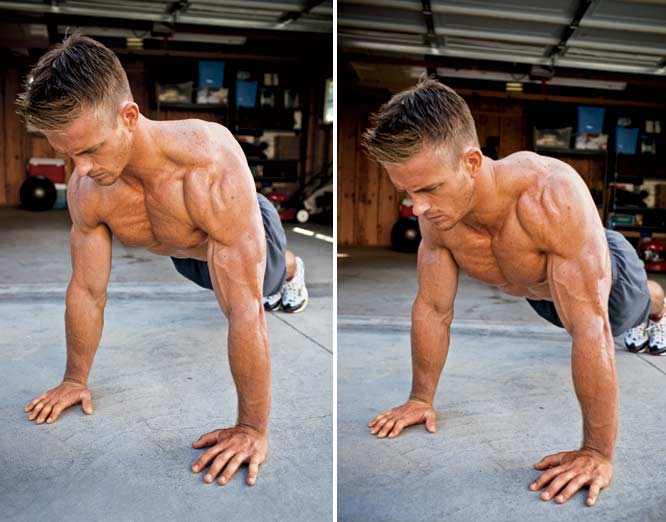
START:
Get in push-up position with your hands shoulder-width apart. Your body should form a straight line from head to ankles. Keep your core tight.
EXECUTION:
Push yourself up, then lower by squeezing your shoulder blades together. Keep your arms straight, and your spine and legs rigid and in a straight line. Engage your core to keep your body moving only at your shoulder complex.
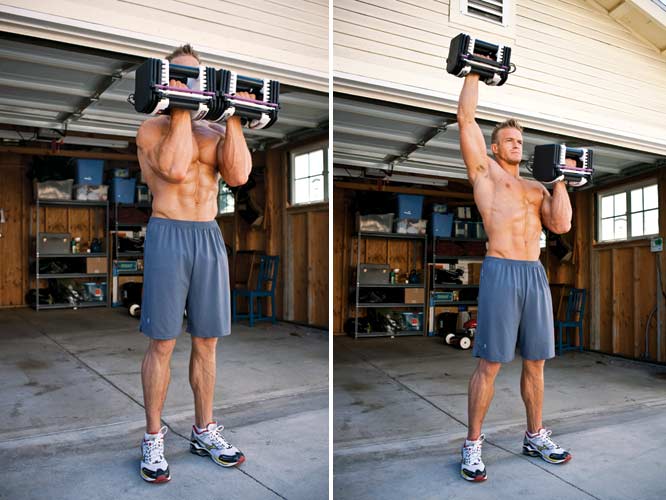
START:
Stand erect with your feet hip-width apart, holding a pair of dumbbells at shoulder level with your palms facing you. Your elbows should be in front of your body. Keep your knees slightly bent and your core tight.
EXECUTION:
As you press one dumbbell overhead, rotate your wrist so your palm faces forward at the top. Lower the weight along the same path so your palm faces in at the bottom. Alternate sides for reps.
QUICK TIP: THIS IS AN ISOLATION MOVE, SO DON’T USE YOUR HIPS AND LEGS TO CHEAT THE WEIGHT UP
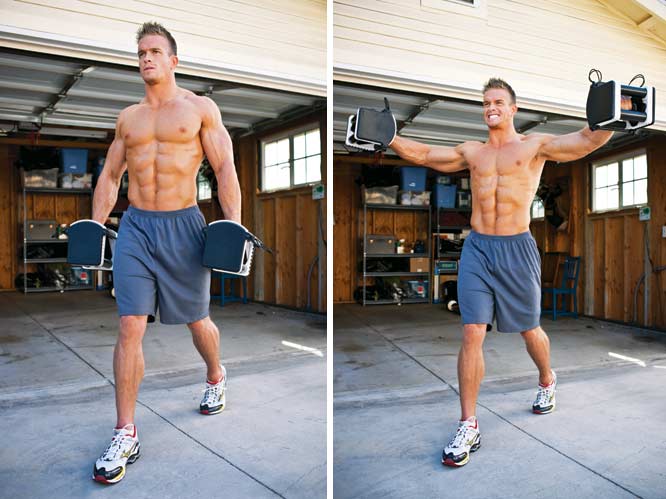
START:
Stand erect holding a pair of dumbbells at your sides and step forward with one foot. Keep your core tight, your body upright and your elbows bent slightly, palms in.
EXECUTION:
Raise your arms out to your sides in an arc until the dumbbells are at approximately shoulder level. Slowly lower the weights to your sides without moving the rest of your body.
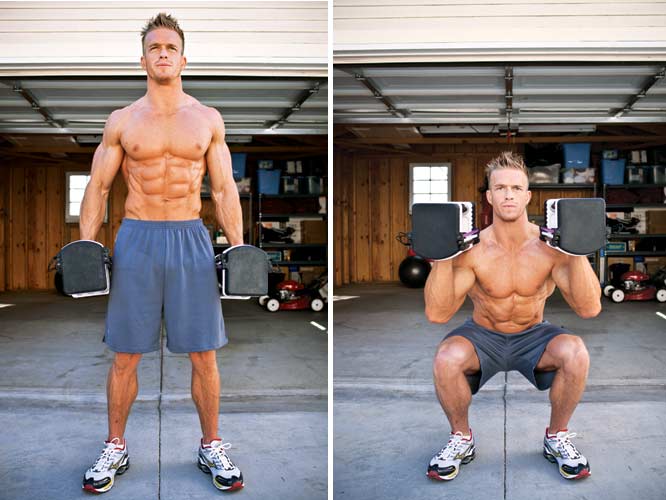
START:
Stand erect with your feet hip-width apart, holding a pair of dumbbells at your sides using a neutral grip. Keep your core tight throughout the movement.
EXECUTION:
In one motion squat and curl the dumbbells to shoulder level. Return to standing, then perform a partial squat and explosively press the weights overhead, pausing for a second at the top. Lower the dumbbells first to your shoulders and then back to your sides. M&F
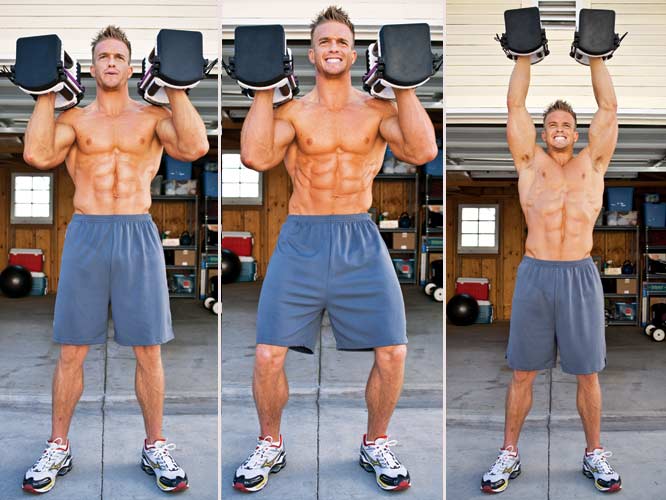
QUICK TIP: BEGIN THE SQUAT BY PUSHING YOUR HIPS BACK, DIRECTING YOUR GLUTES BETWEEN YOUR FEET AND KEEPING YOUR KNEES AS FAR BACK AS POSSIBLE.
Notifications